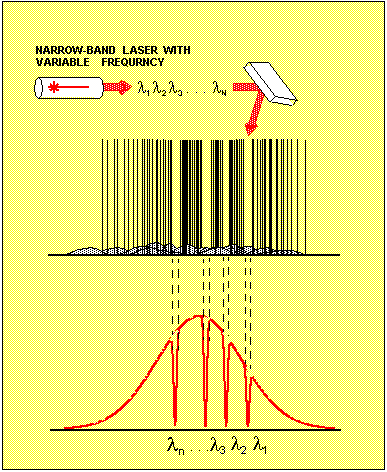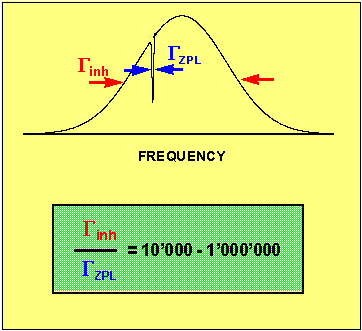Frequency-Selective Optical Storage

Figure 6. The principle of data storage using spectral hole burning. A narrow-band laser with variable frequency bleaches out ZPLs within narrow intervals of the inhomogeneous absorption band.

Figure 7. The ultimate number of bits that can be recorded in a small volume of the material is given by the ratio between the inhomogeneous and homogeneous line width.
Quite independent from any particular photochemical or photophysical SHB mechanism, hole burning provides a unique possibility to alter, by illumination with light, the absorption coefficient of the media (and correlated to it via Kramers-Kronig dispersion relations index of refraction), with very high selectivity and precision in the frequency dimension. Figure 6 shows a rather straightforward idea how to apply this for optical data storage. If the inhomogeneous band comprises many thousands of different ZPL frequencies, then we can illuminate the media with a variable frequency narrow band laser and decrease its absorption at a number of selected frequencies by bleaching out part of the resonantly absorbing molecules. When measuring the absorption profile of media some time afterwards, these frequencies appear as dips or holes in the inhomogeneous band profile. By assigning data bits to the holes in the absorption spectrum we can record and play back digital information. The main interesting thing about spectral hole burning is that in comparison to other, more traditional optical data storage techniques is promises a very high storage density. Theoretically, the SHB storage density is higher by a factor given by the ratio between the inhomogeneous bandwidth and the homogeneous ZPL line width (Figure 7). An optimistic estimate would be that each small diffraction-limited spot or volume of the SHB media can store as much as 104 - 105 bits of data. Adjacent spatial locations can be addressed independently either by steering the laser beam or by rotating the media like in a CD player. In each spatial location the bits are addressed by tuning rapidly the frequency of the laser beam. The density can be then as high as 10 Gbits/cm2 for recording in a plane and 100 Gbits/cm3 when recording in a volume. There are, however, several technical and fundamental problems that have to be addressed before SHB storage devices will become practical. Some of the actual research objectives are listed below.
- materials that pertain high inhomogeneous/homogeneous ratio at room temperature;
- material that allow multiple read-out without gradual erasure of the data;
- material with high SHB efficiency and subpicosecond response time;
